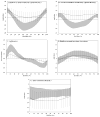Kinetics and kinematics after the Bridle procedure for treatment of traumatic foot drop
- PMID: 23684087
- PMCID: PMC3934630
- DOI: 10.1016/j.clinbiomech.2013.04.008
Kinetics and kinematics after the Bridle procedure for treatment of traumatic foot drop
Abstract
Background: The Bridle procedure restores active ankle dorsiflexion through a tri-tendon anastomosis of the tibialis posterior, transferred to the dorsum of the foot, with the peroneus longus and tibialis anterior tendon. Inter-segmental foot motion after the Bridle procedure has not been measured. The purpose of this study is to report kinetic and kinematic variables during walking and heel rise in patients after the Bridle procedure.
Methods: 18 Bridle and 10 control participants were studied. Walking and heel rise kinetic and kinematic variables were collected and compared using an ANOVA.
Findings: During walking the Bridle group, compared with controls, had reduced ankle power at push-off [2.3 (SD 0.7) W/kg, 3.4 (SD 0.6) W/kg, respectively, P<.01], less hallux extension during swing [-13 (SD 7)°, 15 (SD 6)°, respectively, P<.01] and slightly less ankle dorsiflexion during swing [6 (SD 4)°, 9 (SD 2)°, respectively, P=.03]. During heel rise the Bridle group had 4 (SD 6)° of forefoot on hindfoot dorsiflexion compared to 8 (SD 3)° of plantarflexion in the controls (P<.01).
Interpretation: This study provides evidence that the Bridle procedure restores the majority of dorsiflexion motion during swing. However, plantarflexor function during push-off and hallux extension during swing were reduced during walking in the Bridle group. Abnormal mid-tarsal joint motion, forefoot on hindfoot dorsiflexion instead of plantarflexion, was identified in the Bridle group during the more challenging heel rise task. Intervention after the Bridle procedure must maximize ankle plantarflexor function and midfoot motion should be examined during challenging tasks.
Copyright © 2013 Elsevier Ltd. All rights reserved.
Figures



Similar articles
-
Kinematics and kinetics of single-limb heel rise in diabetes related medial column foot deformity.Clin Biomech (Bristol). 2014 Nov;29(9):1016-22. doi: 10.1016/j.clinbiomech.2014.08.011. Epub 2014 Aug 27. Clin Biomech (Bristol). 2014. PMID: 25218437 Free PMC article.
-
Outcomes of the Bridle Procedure for the Treatment of Foot Drop.Foot Ankle Int. 2015 Nov;36(11):1287-96. doi: 10.1177/1071100715593146. Epub 2015 Jul 9. Foot Ankle Int. 2015. PMID: 26160388 Free PMC article.
-
Midfoot and ankle motion during heel rise and gait are related in people with diabetes and peripheral neuropathy.Gait Posture. 2021 Feb;84:38-44. doi: 10.1016/j.gaitpost.2020.11.013. Epub 2020 Nov 16. Gait Posture. 2021. PMID: 33264731 Free PMC article.
-
Bridle procedure combined with a subtalar implant: a case series and review of the literature.Foot Ankle Spec. 2015 Feb;8(1):29-35. doi: 10.1177/1938640014548319. Epub 2014 Aug 24. Foot Ankle Spec. 2015. PMID: 25156098 Review.
-
Contributions to the understanding of gait control.Dan Med J. 2014 Apr;61(4):B4823. Dan Med J. 2014. PMID: 24814597 Review.
Cited by
-
Body mass index and maximum available midfoot motion are associated with midfoot angle at peak heel rise in people with type 2 diabetes mellitus and peripheral neuropathy.Foot (Edinb). 2022 May;51:101912. doi: 10.1016/j.foot.2022.101912. Epub 2022 Feb 11. Foot (Edinb). 2022. PMID: 35255403 Free PMC article.
-
Kinematics and kinetics of single-limb heel rise in diabetes related medial column foot deformity.Clin Biomech (Bristol). 2014 Nov;29(9):1016-22. doi: 10.1016/j.clinbiomech.2014.08.011. Epub 2014 Aug 27. Clin Biomech (Bristol). 2014. PMID: 25218437 Free PMC article.
-
Heel Rise and Non-Weight-Bearing Ankle Plantar Flexion Tasks to Assess Foot and Ankle Function in People With Diabetes Mellitus and Peripheral Neuropathy.Phys Ther. 2021 Jul 1;101(7):pzab096. doi: 10.1093/ptj/pzab096. Phys Ther. 2021. PMID: 33735386 Free PMC article.
-
Fifteen-Year Follow-up of the Modified Oblique Keller Capsular Interposition Arthroplasty Compared to Arthrodesis for Treatment of Advanced First Metatarsophalangeal Joint Arthritis.Foot Ankle Orthop. 2025 Mar 20;10(1):24730114251322766. doi: 10.1177/24730114251322766. eCollection 2025 Jan. Foot Ankle Orthop. 2025. PMID: 40114855 Free PMC article.
-
Use of computed tomography to identify muscle quality subgroups, spatial mapping, and preliminary relationships to function in those with diabetic peripheral neuropathy.Gait Posture. 2024 Jul;112:159-166. doi: 10.1016/j.gaitpost.2024.05.016. Epub 2024 May 14. Gait Posture. 2024. PMID: 38797052 Free PMC article.
References
-
- McCall RE, Frederick HA, McCluskey GM, Riordan DC. The Bridle procedure: a new treatment for equinus and equinovarus deformities in children. J Pediatr Orthop. 1991;11:83–89. - PubMed
-
- Gellman RE, Anderson RB, Davys HJ. Bridle Posterior Tibial Tendon Transfer. In: Kitaoka HB, editor. Foot Ankle. 2. Lippincott Williams & Wilkins; Philadelphia, PA: 2002. pp. 597–613.
-
- Rodriguez R. The Bridle procedure in the treatment of paralysis of the foot. Foot Ankle. 1992;13:63–69. - PubMed
Publication types
MeSH terms
Grants and funding
LinkOut - more resources
Full Text Sources
Other Literature Sources
Medical

